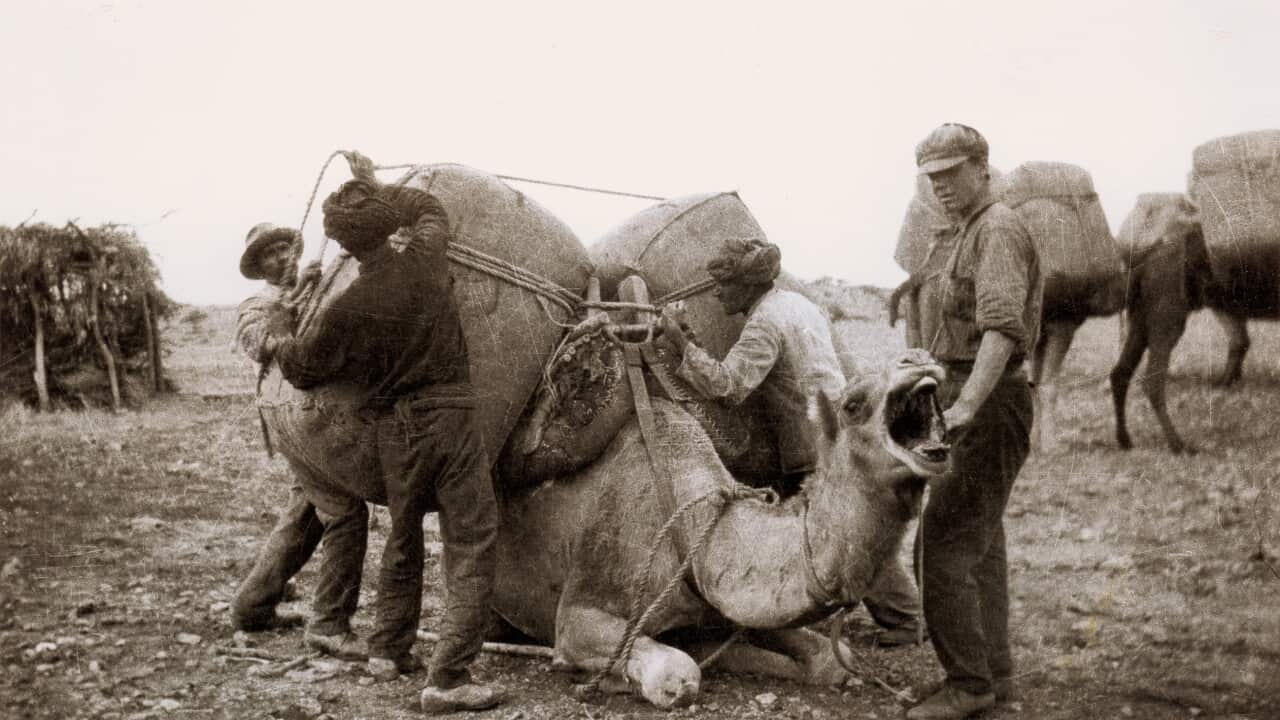Key Points
- Historians and descendants gathered in Broken Hill to remember the early cameleers
- Cameleers from India and Afghanistan led camel trains bringing vital supplies to inland Australia
- While most cameleers returned home, some stayed to make a new life in Australia, often marrying local women
Historian, author and event organiser, Pamela Rajkowski OAM, says the cameleers were 'nation builders' whose work helped Australia transform disparate and far-flung colonies into a federation and nation by 1901.
"With their languages, names, culture, food styles, halal practice and traditions, date palms, and Mohammedan sections of cemeteries, they are an integral part of the multiculturalism of this nation’s DNA," Ms Rajkowski said.
At the event, also organised by James Daily, President of the Broken Hill Historical Society, Ms Rajkowski donated several items to Broken Hill's Mosque Museum.
Among these were a cameleer saddle and an original freight charge list.
Broken Hill, situated 1000km west of Sydney, 837km north west of Melbourne and 511km north east of Adelaide, was once a hub for the push to develop infrastructure in Australia's 'red centre'.
Ms Rajkowski, the author of 'Tracks of the Camel Men', says she donated the charge list because of its symbolism for the cameleers.
“The cameleers had no union. They were forbidden to belong to a union and so one day they wanted to just put up a list of their freight charges so everybody understood what their charges were so they would not be exploited or undermined,” she said.

Two Afghan handlers and their camels, one of which is wearing a traditional decorative harness circa 1890. Credit: State Library of South Australia

Broken Hill Mosque Museum curator and cameleer descendant, Bobby Shamroze, with his grandson Ammin. Credit: Janet Shamroze

The headstone of Broken Hill cameleer, Kie Shirdell, with both Arabic and Farsi calligraphy. Credit: Janet Shamroze
The celebrations involved the translation of headstones in Broken Hill cemetery's Cameleers’ Mohammedan section.
Ms Rajkowski says such celebrations were essential to Australians understanding that many races helped to establish the country.
This recognition also combats stereotypes and reduces intolerance and racism.

Cameleer descendant Bobby Shamroz in traditional Afghan dress and turban sprinkles water on the graves of cameleers in the Broken Hill cemetery on the understanding that it brings comfort to the dead in their journey in the next life. Credit: Janet Shamroze
Vital role in opening up the Outback
Ms Rajkowski said various Asian populations moved throughout the early British colonies in Australia providing labour sources.
"The labourers remained 'aliens' for many decades, they had no political rights and their voices were not recorded in government documents," she said.
"As the colonies on the Australian continent expanded into its interior, it became essential for the importation of an alternative transport animal, the dromedary (camel), with native handlers, to build up a reliable, regular transport infrastructure so that colonial resources could be transferred to the 'mother country', Britain."

Syed Gollamadeen, an assistant to the Mullah in Broken Hill and Marree in the 1930s. Credit: Pamela Rajkowski
According to Ms Rajkowski, they sustained remote pastoral sheep [wool] and cattle stations both on coastal locations and across the continent.
"They serviced copper and gold remote mining settlements and backloaded wool, copper and gold ore to ports," she said.
The cameleers mostly came from Afghanistan hence their nickname of 'Ghan'.

A hand-drawn map by historian Pamela Rajkowski showing all of the Australian towns served by cameleers and their camel trains. Credit: Pamela Rajkowski
'Ships of the desert' were better than horses
Camels provided a resilient alternative for the transportation of goods between several states, cities, and towns in Australia.
READ MORE

Who brought camels to Australia?
Although requiring lower maintenance and less water than horses or bullocks, the desert animal required special care and handling, hence the need for cameleers who cared for and walked alongside the animals.
Ms Rajkowski says as the Australian colonies developed further into the inhospitable interior, repeater stations along the way required a haulage infrastructure not impeded by drought or lack of feed.

Camels being unloaded at an Australian port in the late nineteenth century. Credit: State Library of Australia
"In 1866, 1884 and 1893, he imported commercial numbers of camels and camel handlers (cameleers). These disembarked at Port Augusta (in South Australia), walked to Elders' Beltana Station and by 1889, had established camel haulage centres in Farina and Marree.
"By the 1880s, mining at Broken Hill created an outback town which gained a rail terminus. The town attracted a large cameleers' community centred around a mosque, camel yards and family homes."

Visitors to the Broken Hill tribute to cameleers held in late October 2022 gather around descendant Booby Shamroze with questions while others browse historical displays. Credit: Janet Shamroze
In the 1890s, Marree in South Australia was known as “Little Asia” because of the large population of cameleers. Once a year, their contributions are remembered through the popular Camel Cup races.
The camel trains represented a turning point in the development of Australia – they carried equipment for gold miners in Western Australia, wool sheared around Broken Hill and materials for the construction of the Overland Telegraph.

Official document belonging to Sultan Aziz, the last cameleer to cart with camels and wagon out of Broken Hill in 1927. Credit: Pamela Rajkowski
The Overland Telegraph greatly lessened Australia's isolation from the rest of the world as it was eventually linked to underwater telegraph cables stretching around the globe.
Most cameleers eventually returned to their homelands, but some stayed and married local women, including Indigenous women.

Crashsa Maude, wife of Broken Hill Mosque Mullah Zaifullah Fazulla, with the couple's two young children. Credit: Pamela Rajkowski


